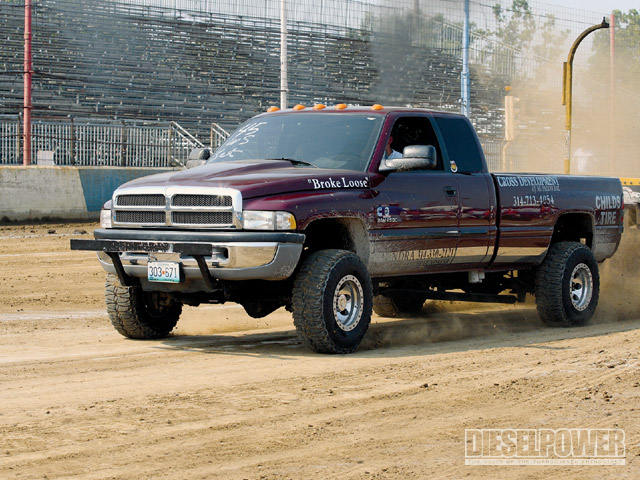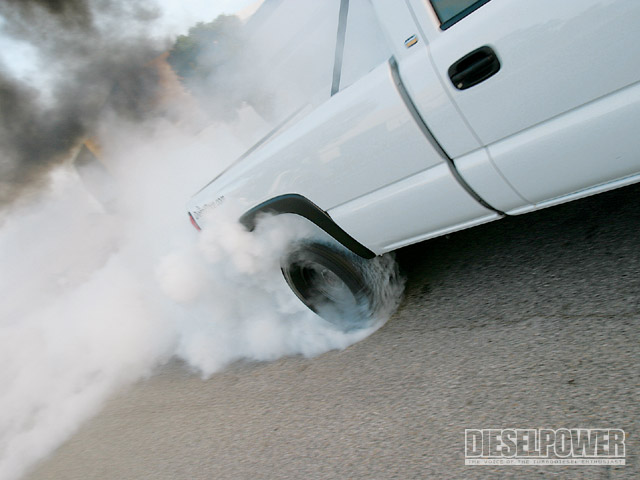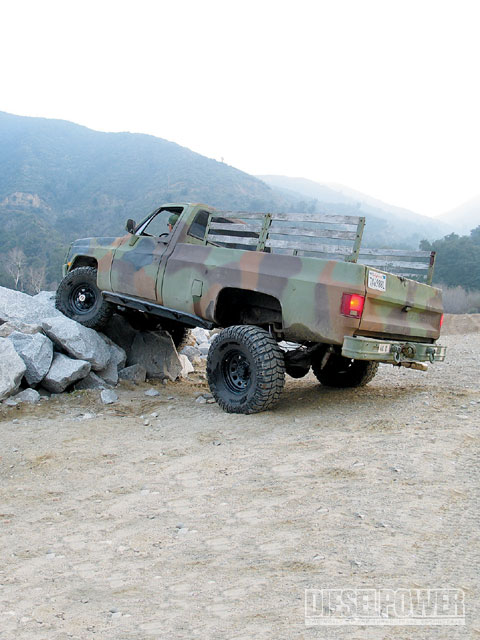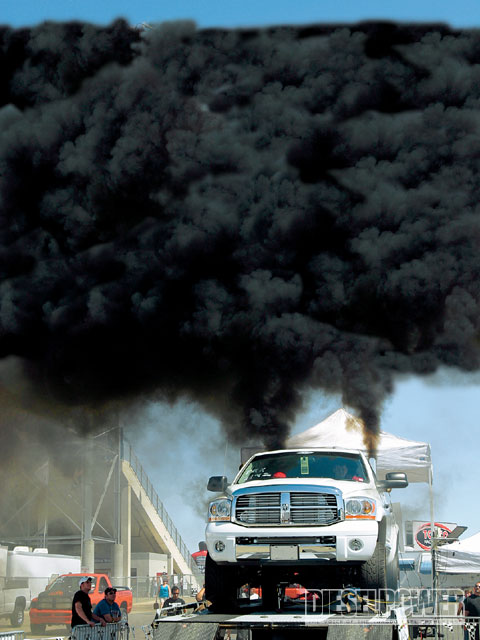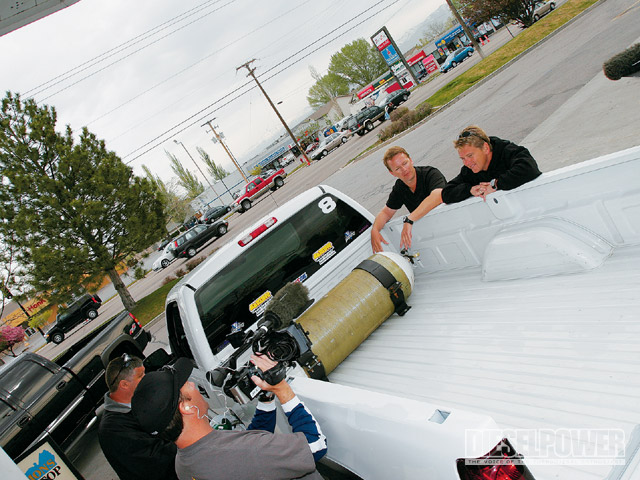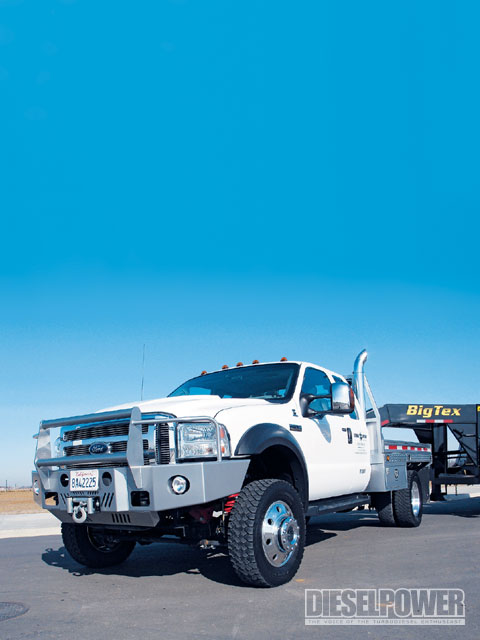Building A Diesel Truck - The Perfect Diesel
How To Build A Truck For Towing, Fuel Economy, Horsepower, Working, Sled Pulling, Drag Racing, Going Off-Road, And Winning The Diesel Power Challenge
Here at Diesel Power, each staff member has a specific area in the diesel realm that interests them a little more than others. To play to these strong points, each editor chose two trucks they would build to suit their ideal needs.
0:00 / 0:00
Editor David Kennedy, whose roots can be traced back to the off-road world, would build the ultimate off-road diesel. And, he would also choose to build a truck that could win an event he helped create--a Diesel Power Challenge-winning truck.
It's no secret, Associate Editor Jason Sands likes drag racing and big horsepower, so obviously he would build a drag truck capable of 9-second quarter-mile times, and a truck that could melt down a dyno. Feature Editor Jason Thompson is big on alternative fuels and all-around vehicle efficiency, so he would build a full-size pickup that could achieve 50 mpg, as well as a rolling workshop of a truck on wheels. Feature Editor Mike McGlothlin would be most prone to having two trucks that exhibited a diesel's strongest attribute--torque. He'd build a streetable sled puller for competition, and choose the ultimate tow vehicle to haul other vehicles, toys, and anything else he wanted.
Consistency is the key to winning the Diesel Power Challenge. You need to have a plan and understand that in order to win, you have to place in the top three in each event. Not only would we practice prior to the event, we'd test our combination at Rocky Mountain Raceways.
Our ideal candidate to win the Diesel Power Challenge would be an '03-'06 Dodge Ram 3500 four-door dualie four-wheel drive. Our dyno-winning torque plan would begin with a 6.7L long-block, and then we would add dual CP3 injection pumps, Super Dragon Flow injectors, PhatShaft Racing Compound turbos, head studs, an MLS head gasket, multi-stage nitrous injection to allow us to dial in our combination for high altitude, propane (which would help us win the fuel economy run), a pressure box, and custom tuning. An air-to-water intercooler with an ice chest in the rear would provide better turbo spool up compared to an air-to-air intercooler. Most importantly, we wouldn't make any last minute changes to our truck right before the event. This is how people blow their trucks up.
And, being that we would want as much weight up front as possible, we'd go with a heavy winch bumper with a Warn 16.5ti winch that would act like hanging weight in the sled pull and trailer tow, but wouldn't hurt in the drag race. For maximum traction, we'd go with an ARB Air Locker up front, and an All Season Service spool in the rear, along with 3.73 axle gears. Traction would be accomplished using 285/70R17 all-terrain tires in all six positions.
'03-'06 Dodge Ram 3500 dualie
6.7L Cummins
6.7L long-block, dual CP3 pumps, Super Dragon Flow injectors, PhatShaft Racing Compound turbos, head studs, MLS head gasket, multi-stage nitrous injection, propane, a pressure box, custom tuning
1,000 hp
48RE
NV 273
AAM 925, ARB Air Locker, 3.73 gears
AAM 1150, All Season Service spool
Bilstein shocks, rear traction bars, rear air springs
285/70R17 all-terrain tires
Stock 17-inch aluminum
Heavy winch bumper with Warn 16.5ti winch
Bright paint that would look good on the cover of the magazine
Built for all-around performance, propane injection for mileage, 6.7L engine for peak torque, and tuned at Rocky Mountain Raceways by a previous Diesel Power Challenge winner (Michael Tomac, Chris Werner, or Nick D'Amico)
Don't get us wrong, we'd love to build a Pro-Modified truck with a fiberglass body, a tube-chassis frame, and hang all kinds of weight out front, but the 2.6-inch-diameter inducer class is where it's at for the mainstreamer. We would opt for a second-generation Dodge 2500 extended cab.
First, we'd take our second-gen to a well-known shop in Terre Haute, Indiana, and let Dan Scheid turn our 12-valve into a high-rpm screamer. We would opt for a custom 66mm S400 turbo from Scheid, a Scheid-built, streetable 913 P-pump (Lightning pump) with the fuel plate set conservatively, Scheid injectors, 5,000rpm governor spring kit, head studs, fire-ringed head, the works. There's no doubt in our minds that Scheid Diesel could build us a 700hp 2.6 truck.
An NV4500 five-speed transmission and a double-disc Southbend clutch would get us off the line. We would outfit the front Dana 60 with an ARB Air Locker, and the rear Dana 80 with a spool. We would also go with 4.10 axle gearing, and pull in 4-Lo, Fourth gear.
Granted, this has been done before, but that is the point. You can be competitive with nearly any setup you want, be it a Duramax running a turbo reducer, a common-rail Cummins, or an old-school P-pumped 12-valve. Oftentimes in the 2.6 classes, the difference between First Place and Fifth Place is only a few feet! That's how competitive and fun this class is becoming.
'94-'02 Dodge 2500
5.9L Cummins 12-valve
13mm P-pump (Lightning Pump) with laser-cut delivery valves, 5x.015 Scheid injectors, S400 turbo by Scheid, a 5,000rpm governor spring kit, head studs, fire-ringed head, Arias forged pistons, Crower connecting rods, street-pulling cam
700 hp
NV4500 (South Bend double-disc 3850 Street Comp clutch)
NP 241
Dana 60 with ARB Air Locker
Dana 80 with spool
Stock
33x13.50x16 TrXus STS from Interco, 8-ply for durability and 10-inch tread width for traction
16-inch beadlocks
Custom ballast, which can be used up front or mounted in the bed (depending on given track rules)
Plain-jane paint job, sleeper until spooled and leaving the line
Big P-pump with plenty of fuel, broad rpm range, and Scheid-built
Lighter is better in the drag racing world, so our drag truck build would be centered around a two-wheel-drive GMC 2500HD powered by the Duramax diesel. We'd try to find one that was wrecked or had a bad transmission, and then we'd tub the rear end, put in a fabricated 9-inch rear axle and a ladder bar rear suspension. The transmission would be a 47RE from Sun Coast (known as a DuraFlite) adapted to the Duramax engine with a stand-alone controller for torque converter lockup and overdrive.
The engine is where we'd do something very different. The stock engine of whatever year truck we got would have its water passages half filled with Hard Blok, a stud girdle, and aftermarket connecting rods. We'd also install an aftermarket cam and a set of ported cylinder heads. For air, we'd ditch the turbo and install a PSI screw supercharger, which would take about 200 horsepower to turn, but would be capable of producing a smoke-free 70 pounds of boost.
Tuning would be accomplished by EFILive. It's our guess that we could get the truck down around 5,500 pounds, and it would have about 1,200 horsepower. With that kind of power-to-weight ratio, 9-second quarter-mile times at more than 140 mph would be no problem. Oh yeah, and we'd still drive it on the street.
'01-'08 GMC 2500 HD, two-wheel drive
6.6L Duramax
PSI screw supercharger, connecting rods, cam, ported cylinder heads, EFILive tuning
1,200 hp
47RE (Sun Coast DuraFlite)
Stock
Ford 9-inch, 35-spline axles
Ladder bar rear
31x16.5 ET Streets
Lightweight beadlocks
Narrowed rearend
Tubbed
Lightweight, high horsepower, purpose-built
The unpaved world can be a cruel place for street vehicles. Mud, dirt, rocks, and snow are not always conquered with horsepower and torque. Often, they are survived by trucks built with simple heavy-duty components. In the off-road world, traction is more important than dyno numbers, and strength comes from using proven components that won't break--even when you pound on them.
To get the most performance off-road, we'd begin with an older truck so we wouldn't cringe every time we scratched it. The solid axle '82-'91 Chevrolet and GMC K30 1-ton pickups make perfect platforms for off-road vehicles because they were built with some of the burliest drivetrain components ever offered. Though their optional 6.2L engines weren't powerhouses, we're not going to suggest swapping the engine out right away because their high compression ratio gives these engines better throttle response than modern diesels. Instead, we'd upsize it with a later-model 6.5L long-block for more power.
'82-'91 GM K30 ('84-'86 military CUCV preferred)
6.5L
Banks Sidewinder turbo system
220 hp
TH400 three-speed automatic
Offroad Design Doubler with JB Conversions LoMax 205
Dana 60, ARB Air Locker, 5.13 gears, 35-spline chromoly axleshafts, Dynatrac differential cover
14-Bolt, Detroit Locker, 5.13 gears, Dynatrac differential cover
Offroad Design 6-inch lift front and rear system
42x14.50R17 BFGoodrich Mud-Terrain T/A KM2
17x8.5-inch Hutchinson Rock Monster beadlocks
Offroad Design steering box brace and High Steer crossover steering kit, PSC ram-assist steering box with hydraulic ram
Offroad Design tubular front winch bumper and Offroad Design 1-inch body lift, substantial fender trimming for tire clearance
Bulletproof drivetrain components providing optimum traction, simple 6.5L engine, purpose-built
An '03-'07 Dodge 2500 with a common-rail engine would get the nod as our dyno king project vehicle, although there is a twist. We'd add a cam to the engine, port the head, and then add a P-pump off of an older 12-valve engine. We'd rely on a triple-stage turbo system for instant boost on the rollers, and about five stages of nitrous to spool it up. After all, the engine only has to make power for a couple of seconds on a dynamometer, so why not run 130 psi of boost and a five-stage nitrous system? We'd also inject water to make sure our engine didn't melt, and we'd add fire-rings and studs to the engine to make sure our head gasket stayed in one piece.
The transmission would be a one-speed reverser for ultimate strength, and our aim would be to break 1,500 horsepower at the wheels. We'd cover the truck with some garish paint scheme that would draw a lot of attention, and try to get sponsors. If our truck still wasn't the baddest one out there, we'd install a combining box like they use on tractor pullers, and add a second Cummins engine, with the same turbo and nitrous setup as the first one. Then nobody could beat us.
'03-'07 Dodge 2500
5.9L Cummins
P7100 injection pump, ported head, cam, triple-stage turbo system, five stages of nitrous, water injection, fire-ringed head, head studs
1,500 hp
Pro Fab reverser, one-speed
Pro Fab drop box
AAM 925
AAM 1150
Stock
Stock
Stock
N/A
Tastelessly colorful paint scheme
Plenty of fuel supply from a P-pump, three turbochargers, and plenty of nitrous
This perfect fuel mileage recipe comes from the results of past trucks competing in the Diesel Power Challenge. In the most recent contest, the Duramax picked up First, Second, and Third place finishes in the fuel economy portion of the competition. This is nothing new. In fact, it is the very same thing that happened in the first Diesel Power Challenge. The highest place Ford has ever reached in this event is Fourth.
We would start with an '06 Duramax-equipped 2500 HD regular cab, which we would outfit with a shortbed. The next modification would be an adjustable air spring suspension so our truck ride would be as low as possible when on the highway. We would rely more on water injection for cooling, so our grille opening could be smaller for better aerodynamics. Fiberglass, carbon fiber, Lexan, and aluminum would be used in place of steel and glass wherever practical. The rear AAM 11 -inch rear axle would get the highest gears possible (3.42). EFILive would help tune our engine for maximum fuel efficiency. Alternative fuels such as CNG, propane, and hydrogen would all be added to the Duramax through electronic controllers tied into the main engine computer. Our goal would be 50 mpg.
'06 Chevy 2500 HD standard cab, two-wheel drive
6.6L Duramax
Water injection, CNG and propane fumigation, a hydrogen-on-demand system powered by a driveshaft alternator and two batteries, and EFILive tuning
300 hp
ZF six-speed
AAM 1150 with 3.42 gearing
Adjustable air shocks
Low-rolling resistance Michelin X radials
Light aluminum
Shortbed
Fiberglass, carbon fiber, aluminum, and Lexan replacing glass and steel
Lightweight, two-wheel drive, highly geared, EFILive tuning, CNG, propane, and hydrogen
Numbers speak volumes in the towing world, and the new F-450's are unmatched in towing capability from the factory. From its 14.53-inch front and 15.53-inch rear disc brakes to its 5,830-pound payload capacity to its maximum Gross Combined Weight Rating (GCWR) of 30,000 pounds, everything about the F-450 is "Super Duty." Our ideal tow rig would be a four-wheel-drive '09 F-450 Super Duty with a solid axle up front and the Dana S110 with 4.88 gearing in the rear. And, fitting for any heavy hauler, we'd get the 19-inch factory wheels, which would make our F-450 look like a big rig.
Performance-wise, we'd leave the 6.4L twin-turbo V-8 mill alone. The F-450 Power Stroke engine package is slightly detuned from the lighter duty trucks for a reason--longevity. We think a 325hp, 600lb-ft version of the new Power Stroke, combined with the stout 5R110 automatic transmission, would perform flawlessly, and if properly maintained, could be made to last forever.
'09 F-450
6.4L Power Stroke
None
325 hp
5R110 (TorqShift)
NV 273
Dana 60
Dana S110 with 4.88 gears
Twin coil up front, air spring rear
Six Michelin XRV 225/70R 19.5 (F load range)
19-inch
Super Glide fifth-wheel hitch, 74-gallon auxiliary in-bed fuel tank from Transfer Flow
Radar detector, CB, and GPS
High payload and tow ratings, strong transmission, powerful engine, and remote infrared AgCam cameras with in-cab laptop (for easy backing)
The perfect work truck needs a reliable diesel engine and a custom flatbed with dump capability. We would choose an '03 Ford Super Duty as our foundation since it is a stout platform, ran for many years, and plenty of replacement parts exist. It also came with the durable, intercooled 7.3L Power Stroke. We would also opt for the proven 4R100 automatic transmission, which is reliable behind an unmodified 7.3L engine and easier to drive for other employees.
In this case, performance engine modifications are not critical, so we would focus more on the truck's suspension and it's functionality from the cab back. An air spring suspension would help control heavy loads, and a custom aluminum flatbed with dump capability would make difficult tasks much easier.
'03 Ford Super Duty F-450/F-550
7.3L Power Stroke
N/A
250 hp
4R100
NV 271
Dana 60
Dana 135
Air spring rear
Best price available with E or F load range
Stock
Aluminum dump bed with aluminum storage compartments
White paint (hides scratches)
The reliable 7.3L engine and transmission, flat/dump bed, functionality



